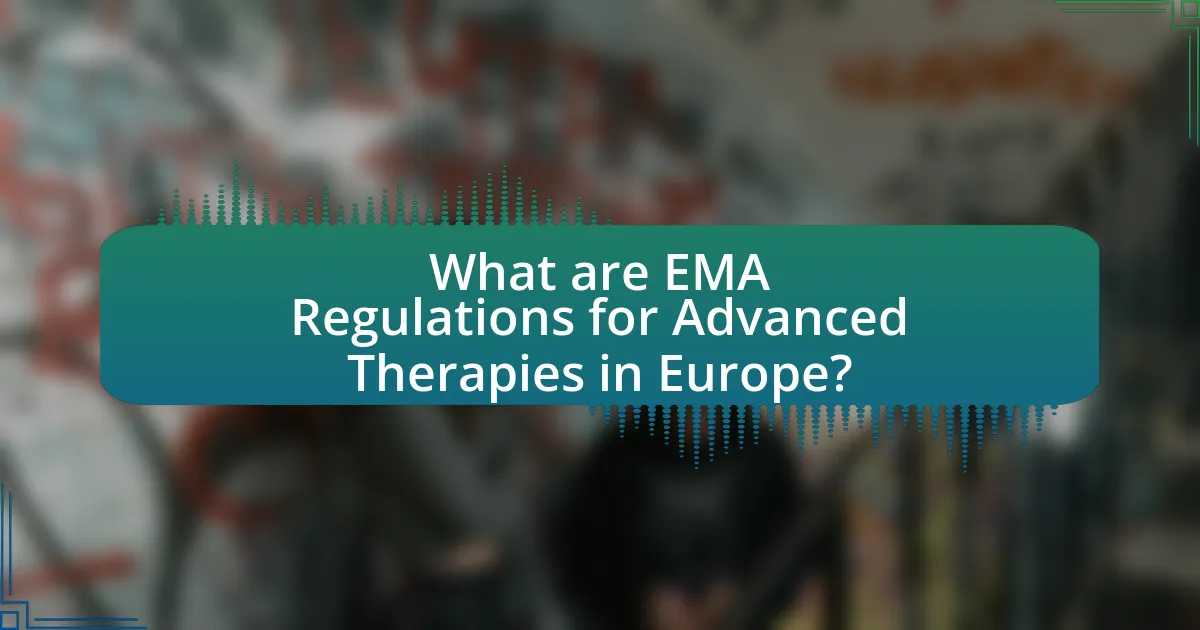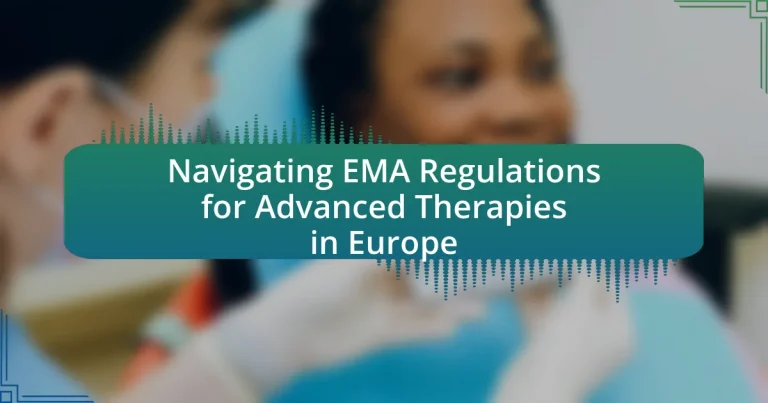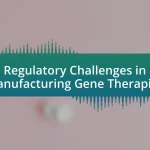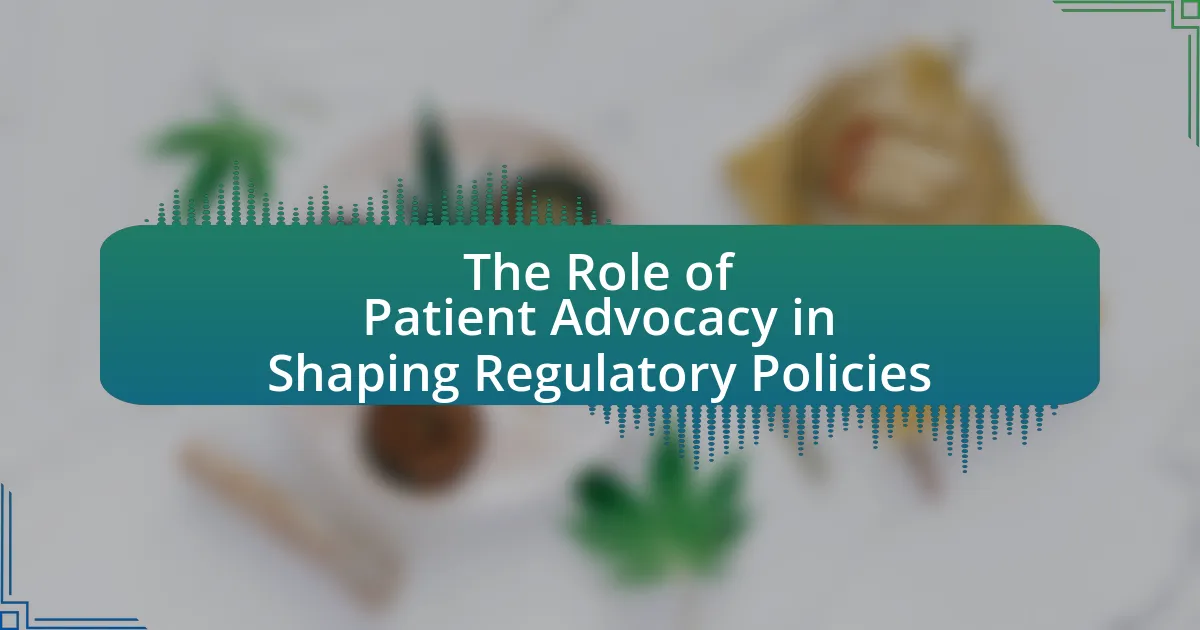The article focuses on the European Medicines Agency (EMA) regulations for advanced therapy medicinal products (ATMPs), which encompass gene therapies, somatic cell therapies, and tissue-engineered products. It outlines the regulatory framework established by Regulation (EC) No 1394/2007, detailing the rigorous processes for development, assessment, and monitoring of these therapies to ensure safety, efficacy, and quality. Key topics include the impact of EMA regulations on therapy development, the evaluation process for ATMPs, the challenges faced by developers, and best practices for navigating the regulatory landscape. Additionally, the article emphasizes the importance of compliance with Good Manufacturing Practices (GMP) and post-marketing surveillance requirements to maintain patient safety and therapeutic effectiveness.

What are EMA Regulations for Advanced Therapies in Europe?
EMA regulations for advanced therapies in Europe are established to ensure the safety, efficacy, and quality of advanced therapy medicinal products (ATMPs), which include gene therapies, somatic cell therapies, and tissue-engineered products. These regulations are primarily outlined in Regulation (EC) No 1394/2007 and are complemented by the European Medicines Agency’s guidelines, which provide a framework for the development, assessment, and monitoring of ATMPs. The regulations require that ATMPs undergo rigorous clinical trials and must receive marketing authorization from the EMA before being made available to patients, ensuring that all products meet stringent safety and efficacy standards.
How do EMA regulations impact the development of advanced therapies?
EMA regulations significantly influence the development of advanced therapies by establishing a framework that ensures safety, efficacy, and quality. These regulations require developers to adhere to stringent clinical trial protocols, which can extend the timeline and increase costs associated with bringing therapies to market. For instance, the EMA’s Committee for Advanced Therapies (CAT) provides guidance on the regulatory pathway, ensuring that developers understand the necessary requirements for product approval. This structured approach aims to protect patients while fostering innovation, as evidenced by the increased number of advanced therapy medicinal products (ATMPs) receiving marketing authorization in recent years, reflecting the balance between regulatory oversight and the need for therapeutic advancements.
What types of advanced therapies are covered under EMA regulations?
The European Medicines Agency (EMA) regulations cover three main types of advanced therapies: gene therapies, somatic cell therapies, and tissue-engineered products. Gene therapies involve the modification of genetic material to treat or prevent diseases, somatic cell therapies utilize cells that have been manipulated for therapeutic purposes, and tissue-engineered products are created by combining cells and biomaterials to repair or replace damaged tissues. These classifications are defined under the Regulation (EC) No 1394/2007 on advanced therapy medicinal products, which establishes the framework for their evaluation and authorization in the European Union.
Why are EMA regulations crucial for patient safety and efficacy?
EMA regulations are crucial for patient safety and efficacy because they establish rigorous standards for the evaluation and approval of medical products. These regulations ensure that therapies undergo comprehensive clinical trials to assess their safety, effectiveness, and quality before reaching patients. For instance, the EMA requires that all new medicines demonstrate a favorable benefit-risk balance, which is supported by data from clinical studies. This systematic approach minimizes the risk of adverse effects and ensures that only safe and effective treatments are available to patients, thereby protecting public health.
What is the role of the European Medicines Agency in regulating advanced therapies?
The European Medicines Agency (EMA) plays a crucial role in regulating advanced therapies by evaluating and approving gene therapies, somatic cell therapies, and tissue-engineered products. The EMA ensures that these therapies meet stringent safety, efficacy, and quality standards before they can be marketed in the European Union. This regulatory oversight is guided by the Advanced Therapy Medicinal Products Regulation (Regulation (EC) No 1394/2007), which establishes a framework for the development and authorization of advanced therapies, ensuring patient safety and promoting innovation in the field.
How does the EMA evaluate advanced therapy medicinal products (ATMPs)?
The European Medicines Agency (EMA) evaluates advanced therapy medicinal products (ATMPs) through a comprehensive assessment process that includes scientific evaluation, risk-benefit analysis, and compliance with regulatory standards. This evaluation process involves the Committee for Advanced Therapies (CAT), which specializes in reviewing ATMPs and provides recommendations based on the quality, safety, and efficacy of the products. The EMA also considers data from clinical trials, manufacturing processes, and post-market surveillance to ensure that ATMPs meet the necessary requirements for authorization. This rigorous evaluation framework is designed to protect public health while fostering innovation in advanced therapies.
What are the key stages in the EMA approval process for advanced therapies?
The key stages in the EMA approval process for advanced therapies include preclinical evaluation, clinical trial application, clinical trials, marketing authorization application, and post-marketing surveillance. Initially, preclinical evaluation assesses the therapy’s safety and efficacy through laboratory and animal studies. Following this, a clinical trial application is submitted to the EMA, which reviews the proposed study protocols. Once approved, clinical trials are conducted in phases to gather data on safety and efficacy in humans. After successful trials, a marketing authorization application is submitted, where the EMA evaluates the comprehensive data before granting approval. Finally, post-marketing surveillance monitors the therapy’s long-term effects and safety in the general population. Each stage is critical to ensure that advanced therapies meet stringent safety and efficacy standards before reaching patients.
What challenges do developers face when navigating EMA regulations?
Developers face significant challenges when navigating EMA regulations, primarily due to the complexity and evolving nature of the regulatory framework. The European Medicines Agency (EMA) has stringent requirements for advanced therapies, including detailed documentation, extensive clinical trial data, and compliance with Good Manufacturing Practices (GMP). These requirements can lead to delays in the approval process, as developers must ensure that their products meet all regulatory standards before submission. Additionally, the lack of clear guidance on certain aspects of advanced therapy medicinal products (ATMPs) can create uncertainty, making it difficult for developers to anticipate regulatory expectations. This complexity is compounded by the need for ongoing communication with regulatory authorities, which can be resource-intensive and time-consuming.
How can developers prepare for regulatory submissions?
Developers can prepare for regulatory submissions by thoroughly understanding the specific requirements set forth by the European Medicines Agency (EMA) for advanced therapies. This preparation involves compiling comprehensive documentation, including clinical trial data, manufacturing processes, and risk assessments, to demonstrate the safety and efficacy of the therapy. Additionally, developers should engage in early dialogue with the EMA to clarify expectations and receive guidance on the submission process. Historical data shows that early interactions with regulatory bodies can significantly enhance the likelihood of successful submissions, as evidenced by the increased approval rates for therapies that underwent pre-submission consultations.
What common pitfalls should developers avoid during the regulatory process?
Developers should avoid inadequate understanding of regulatory requirements during the regulatory process. This pitfall can lead to non-compliance with the European Medicines Agency (EMA) guidelines, resulting in delays or rejections of applications. Additionally, failing to engage with regulatory authorities early can hinder the development process, as it limits the opportunity for feedback and clarification on expectations. A lack of thorough documentation and data integrity can also jeopardize the approval process, as the EMA requires comprehensive evidence to support claims. Lastly, neglecting post-market surveillance obligations can lead to significant legal and financial repercussions, as ongoing compliance is essential for maintaining market authorization.
How can stakeholders effectively engage with EMA during the regulatory process?
Stakeholders can effectively engage with the European Medicines Agency (EMA) during the regulatory process by participating in public consultations, submitting scientific advice requests, and attending stakeholder meetings. Public consultations allow stakeholders to provide input on regulatory guidelines and policies, ensuring their perspectives are considered. Submitting scientific advice requests enables stakeholders to seek guidance on specific development issues, which can help align their products with EMA expectations. Additionally, attending stakeholder meetings fosters direct communication with EMA representatives, facilitating a better understanding of regulatory requirements and processes. These engagement methods are supported by EMA’s commitment to transparency and collaboration, as outlined in their guidelines for stakeholder involvement.
What resources are available for understanding EMA regulations?
The European Medicines Agency (EMA) provides several resources for understanding its regulations, including official guidelines, training materials, and public consultations. The EMA’s website hosts a comprehensive library of documents, including the “Guidelines on the Quality, Safety, and Efficacy of Advanced Therapy Medicinal Products,” which outlines regulatory requirements. Additionally, the EMA conducts webinars and workshops to educate stakeholders about regulatory processes and updates. These resources are essential for professionals navigating the complex landscape of advanced therapies in Europe, ensuring compliance with the latest regulatory standards.

What are the specific requirements for submitting advanced therapies to the EMA?
The specific requirements for submitting advanced therapies to the European Medicines Agency (EMA) include a comprehensive dossier that demonstrates quality, safety, and efficacy of the therapy. This dossier must adhere to the guidelines set forth in the Regulation (EU) No 1394/2007 on advanced therapy medicinal products, which mandates detailed information on the product’s manufacturing process, preclinical and clinical data, and risk management plans. Additionally, applicants must provide a summary of the product’s characteristics, labeling, and a proposed risk management plan. The EMA also requires compliance with Good Manufacturing Practice (GMP) and Good Clinical Practice (GCP) standards to ensure the integrity and reliability of the data submitted.
What documentation is necessary for EMA submissions?
The documentation necessary for EMA submissions includes the Common Technical Document (CTD), which consists of five modules: Module 1 (Administrative Information and Prescribing Information), Module 2 (Summaries), Module 3 (Quality), Module 4 (Non-Clinical Study Reports), and Module 5 (Clinical Study Reports). Each module contains specific information required for the evaluation of the medicinal product, ensuring compliance with EMA guidelines. The CTD format is standardized and facilitates the review process by providing a comprehensive overview of the product’s quality, safety, and efficacy.
How should clinical trial data be presented to the EMA?
Clinical trial data should be presented to the European Medicines Agency (EMA) in a structured and comprehensive manner, adhering to the guidelines set forth in the EMA’s “Guideline on the Clinical Evaluation of Medicines for Human Use.” This includes providing detailed information on study design, methodology, statistical analysis, and results, ensuring clarity and transparency. The data must be organized into sections such as the introduction, methods, results, and discussion, with appropriate tables and figures to illustrate findings. Additionally, the EMA requires that data be presented in a way that allows for independent verification and reproducibility, which is critical for regulatory assessment.
What are the requirements for manufacturing and quality control documentation?
The requirements for manufacturing and quality control documentation include comprehensive records that demonstrate compliance with Good Manufacturing Practices (GMP) and regulatory standards set by the European Medicines Agency (EMA). These documents must encompass detailed descriptions of manufacturing processes, quality control procedures, batch records, and validation protocols.
Specifically, the documentation should include a Quality Management System (QMS) that outlines the organizational structure, responsibilities, and processes for quality assurance. Additionally, it must provide evidence of product specifications, testing methods, and results to ensure that products meet safety and efficacy standards.
Regulatory guidelines, such as those outlined in the EMA’s “Guideline on Good Manufacturing Practice” (2017), emphasize the necessity for traceability and accountability in all manufacturing and quality control activities, reinforcing the importance of maintaining accurate and complete documentation throughout the product lifecycle.
How does the EMA assess the quality, safety, and efficacy of advanced therapies?
The European Medicines Agency (EMA) assesses the quality, safety, and efficacy of advanced therapies through a rigorous evaluation process that includes scientific review and compliance with regulatory standards. This process involves the submission of comprehensive data from preclinical and clinical studies, which are evaluated by expert committees. The EMA specifically examines the manufacturing processes to ensure quality control, assesses clinical trial results for safety and efficacy, and considers the therapeutic benefit versus risks. The assessment is guided by the Advanced Therapy Medicinal Products Regulation (EC No 1394/2007), which outlines the requirements for these therapies, ensuring that only those meeting stringent criteria are authorized for use in the European market.
What criteria does the EMA use to evaluate clinical trial results?
The European Medicines Agency (EMA) evaluates clinical trial results based on criteria such as efficacy, safety, quality, and risk-benefit assessment. Efficacy is determined by the trial’s ability to demonstrate a therapeutic effect, while safety involves assessing adverse events and overall tolerability. Quality pertains to the consistency and reliability of the data collected, and the risk-benefit assessment weighs the potential benefits against the risks associated with the treatment. These criteria ensure that only therapies meeting rigorous standards are approved for use in Europe, as outlined in the EMA’s guidelines and regulatory framework.
How does the EMA ensure compliance with Good Manufacturing Practices (GMP)?
The European Medicines Agency (EMA) ensures compliance with Good Manufacturing Practices (GMP) through rigorous inspections and assessments of manufacturing facilities. The EMA conducts regular inspections of both domestic and international sites to verify adherence to GMP standards, which are essential for ensuring the quality and safety of medicinal products. These inspections are based on the guidelines set forth in the EU GMP regulations, which require manufacturers to implement quality management systems, maintain proper documentation, and ensure that personnel are adequately trained. Additionally, the EMA collaborates with national competent authorities to monitor compliance and address any deviations from GMP, thereby reinforcing the integrity of the manufacturing process for advanced therapies in Europe.
What are the post-marketing surveillance requirements for advanced therapies?
Post-marketing surveillance requirements for advanced therapies include continuous monitoring of safety and efficacy after market authorization. The European Medicines Agency (EMA) mandates that companies must implement risk management plans, conduct post-authorization safety studies, and report adverse events to ensure ongoing assessment of the therapy’s benefit-risk profile. These requirements are outlined in the EU Regulation No. 536/2014, which emphasizes the need for vigilance in tracking long-term effects and potential risks associated with advanced therapies.
How does the EMA monitor the long-term safety of approved therapies?
The European Medicines Agency (EMA) monitors the long-term safety of approved therapies through a system of pharmacovigilance, which includes the collection and analysis of safety data post-authorization. This process involves continuous monitoring of adverse drug reactions reported by healthcare professionals and patients, as well as conducting periodic safety update reports (PSURs) submitted by the marketing authorization holders. The EMA also collaborates with national regulatory authorities and utilizes databases like EHRs (Electronic Health Records) to assess long-term safety trends. This systematic approach ensures that any emerging safety concerns are promptly identified and addressed, thereby maintaining the therapeutic benefit-risk balance of approved therapies.
What reporting obligations do companies have after approval?
Companies have specific reporting obligations after receiving approval for advanced therapies from the European Medicines Agency (EMA). These obligations include submitting periodic safety update reports (PSURs) to monitor the safety of the therapy, as well as annual reports detailing the product’s performance and any adverse events. Additionally, companies must report any significant changes to the product or its manufacturing process, as stipulated by the EMA guidelines. Compliance with these reporting requirements is essential to ensure ongoing safety and efficacy monitoring, as outlined in the EU pharmacovigilance legislation.

What best practices can help in navigating EMA regulations for advanced therapies?
To navigate EMA regulations for advanced therapies effectively, organizations should implement a structured approach that includes early engagement with the EMA, thorough understanding of regulatory requirements, and robust documentation practices. Early engagement allows for clarification of expectations and guidance on the regulatory pathway, which is crucial given the complexity of advanced therapies. Understanding specific regulations, such as the Advanced Therapy Medicinal Products (ATMP) Regulation (EC No 1394/2007), ensures compliance with safety and efficacy standards. Additionally, maintaining comprehensive documentation throughout the development process supports transparency and facilitates smoother interactions with regulatory authorities. These practices are validated by the EMA’s emphasis on proactive communication and the importance of detailed regulatory submissions in their guidance documents.
How can developers streamline the regulatory submission process?
Developers can streamline the regulatory submission process by implementing electronic submission systems and adopting standardized documentation practices. Electronic submission systems, such as the Common Technical Document (CTD) format, facilitate faster and more efficient data sharing with regulatory authorities. Standardized documentation reduces variability and enhances clarity, which can lead to quicker reviews and approvals. According to the European Medicines Agency (EMA), the use of electronic submissions has significantly decreased the time required for regulatory assessments, improving overall efficiency in the approval process for advanced therapies.
What role does early engagement with the EMA play in successful submissions?
Early engagement with the European Medicines Agency (EMA) significantly enhances the likelihood of successful submissions for advanced therapies. This proactive interaction allows developers to receive timely feedback on their clinical development plans, regulatory requirements, and data expectations, which can lead to more efficient study designs and submission processes. For instance, the EMA’s Scientific Advice procedure provides a structured opportunity for developers to clarify uncertainties and align their strategies with regulatory expectations, ultimately reducing the risk of delays or rejections during the formal submission phase.
How can developers leverage feedback from the EMA effectively?
Developers can leverage feedback from the EMA effectively by systematically integrating it into their product development processes. This involves actively engaging with EMA during the early stages of development to clarify regulatory expectations and gather insights on clinical trial design. By utilizing the EMA’s scientific advice procedures, developers can receive tailored guidance that aligns with regulatory requirements, thereby reducing the risk of costly delays or rejections later in the approval process. For instance, the EMA’s feedback on trial protocols can help refine study designs, ensuring they meet both scientific and regulatory standards, which has been shown to enhance the likelihood of successful market authorization.
What are the key takeaways for successfully navigating EMA regulations?
Key takeaways for successfully navigating EMA regulations include understanding the regulatory framework, engaging with the EMA early in the development process, and ensuring compliance with scientific and ethical standards. The EMA operates under a structured set of guidelines that govern the approval of advanced therapies, which necessitates a thorough knowledge of these regulations. Early engagement with the EMA allows for feedback on development plans, which can significantly streamline the approval process. Compliance with scientific standards, such as demonstrating safety and efficacy through robust clinical trials, is essential for gaining regulatory approval. These practices are supported by the EMA’s emphasis on transparency and collaboration, which facilitates a smoother pathway for advanced therapies to reach the market.
What strategies can enhance compliance with EMA requirements?
Implementing robust quality management systems enhances compliance with EMA requirements. These systems ensure that all processes related to advanced therapies are standardized, monitored, and continuously improved, which aligns with EMA’s emphasis on quality assurance. Additionally, conducting regular training for staff on EMA regulations and guidelines fosters a culture of compliance, ensuring that all team members are aware of their responsibilities. Furthermore, engaging in proactive communication with EMA during the development process allows for early identification of potential compliance issues, facilitating timely resolutions. Evidence from successful pharmaceutical companies indicates that these strategies lead to higher compliance rates and smoother regulatory approvals.
How can developers stay updated on changes in EMA regulations?
Developers can stay updated on changes in EMA regulations by regularly consulting the European Medicines Agency’s official website and subscribing to their newsletters. The EMA publishes updates, guidelines, and regulatory changes that are crucial for developers in the pharmaceutical and biotechnology sectors. Additionally, attending EMA-hosted webinars and workshops provides direct insights into regulatory developments. Engaging with industry associations and forums also facilitates access to shared knowledge and experiences regarding regulatory changes.




